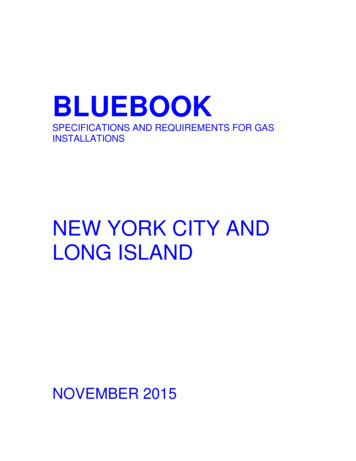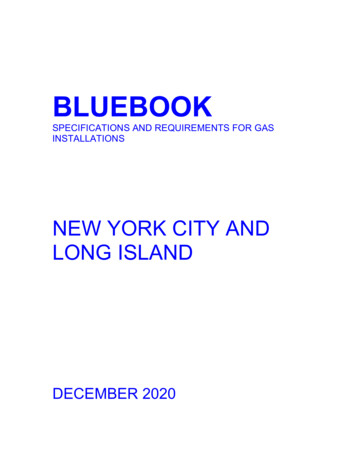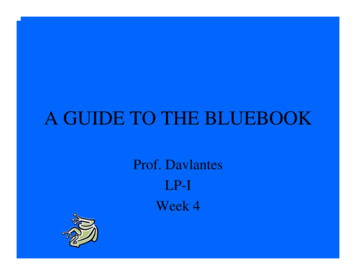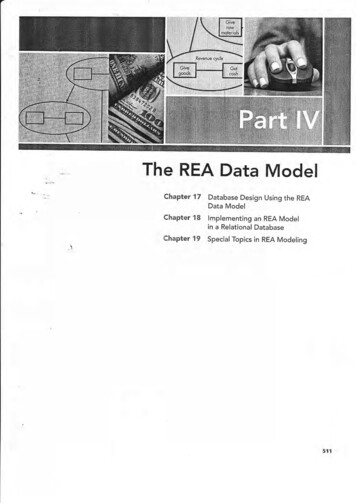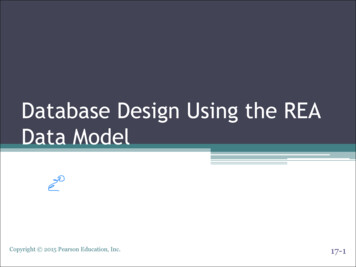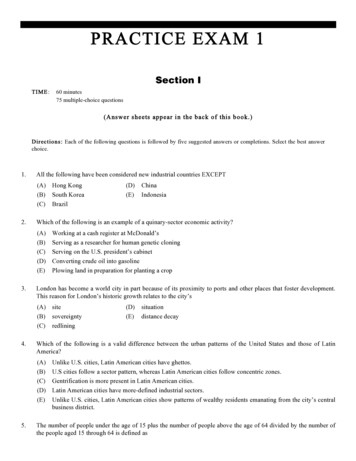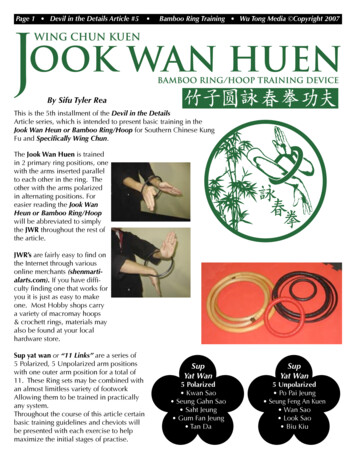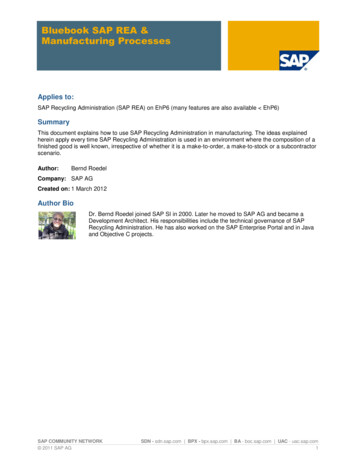
Transcription
Bluebook SAP REA &Manufacturing ProcessesApplies to:SAP Recycling Administration (SAP REA) on EhP6 (many features are also available EhP6)SummaryThis document explains how to use SAP Recycling Administration in manufacturing. The ideas explainedherein apply every time SAP Recycling Administration is used in an environment where the composition of afinished good is well known, irrespective of whether it is a make-to-order, a make-to-stock or a subcontractorscenario.Author:Bernd RoedelCompany: SAP AGCreated on: 1 March 2012Author BioDr. Bernd Roedel joined SAP SI in 2000. Later he moved to SAP AG and became aDevelopment Architect. His responsibilities include the technical governance of SAPRecycling Administration. He has also worked on the SAP Enterprise Portal and in Javaand Objective C projects.SAP COMMUNITY NETWORK 2011 SAP AGSDN - sdn.sap.com BPX - bpx.sap.com BA - boc.sap.com UAC - uac.sap.com1
Bluebook SAP REA & Manufacturing ProcessesTable of ContentsPreliminary Remark . 4Changes. 4Introduction to the REA master data model . 5Simplified data model with article, main packaging and additional components . 7Challenges in manufacturing processes . 9REA master data setup having full product information . 9Using referencing of organizational structures . 9Using referencing on REA article level . 10Using referencing on sales unit level . 11Building REA article master data from Bills of Materials (BOM) . 13Introduction . 13Customizing . 13Assignment of BOMs . 16Building REA article/packaging master data from other sources . 16Using packaging groups. 16Using versioning of master data . 19Uploading REA master data from a flat file . 19Special Case: Dealing with variant configuration . 20Special Case: Batch tracing . 20Managing master data changes . 20Motivation . 20Using change documents to track master data changes . 21Introduction . 21Customizing . 21Dialog . 22Using workflow events to track master data changes . 23Utilizing the REA declaration system to identify missing REA master data . 23Motivation. 23Customizing . 24Dialog . 24Ensuring REA master data consistency. 26Motivation. 26Validating master data by the collective consistency check . 26Leveraging the REA declaration system to validate master data consistency . 27Mass maintenance . 27Consuming transactional data from various sources in REA . 28Using billing documents, material movements, legacy data as data source . 28Combining different sources of transactional data in one run. 30Combining different sources of transactional data from several runs . 30Glossary . 31Appendix . 32Flat file example . 32SAP COMMUNITY NETWORK 2012 SAP AGSDN - sdn.sap.com BPX - bpx.sap.com BA - boc.sap.com UAC - uac.sap.com2
Bluebook SAP REA & Manufacturing ProcessesRelated Content . 37Copyright. 38SAP COMMUNITY NETWORK 2012 SAP AGSDN - sdn.sap.com BPX - bpx.sap.com BA - boc.sap.com UAC - uac.sap.com3
Bluebook SAP REA & Manufacturing ProcessesPreliminary RemarkThe following document is a cookbook for using REA within manufacturing scenarios. The document neitherexplains any customizing activities that influence the transactional behavior, nor does it discuss the recyclingpartner/price list set up. In addition to the master data REA uses terms like recycling partner, price list,license fee or splitting that are all part of a contract between the REA user and a compliance scheme. Thosecontract management tasks are not explained in this document. Of course any process described in thisdocument can be combined with the processes in retail like scenarios ( [12]).After reading this document you should be able to adapt the REA master data model and declaration systemto the requirements of manufacturing like scenarios. Implementation details are often explained in depth inthe documents listed in the appendix.ChangesThis is the initial version.SAP COMMUNITY NETWORK 2012 SAP AGSDN - sdn.sap.com BPX - bpx.sap.com BA - boc.sap.com UAC - uac.sap.com4
Bluebook SAP REA & Manufacturing ProcessesIntroduction to the REA master data modelThe REA master data consists of two main objects: REA article and REA (packaging) component.A REA (packaging) component is based on REA internal fractions. Figure 1 depicts the master data modelschematically. The colors in Figure 1 will be used consistently throughout this document.ArticleComponentFractionFigure 1: REA Master data schemeREA article and REA components refer to the material number in the ERP Material master (MARA-MATNR).Hence REA article cannot exist without a corresponding MM entry. REA packaging components may existwithout a material master entry, if configured appropriately. In addition it also is possible that a REA articleand a REA component refer to the identical MM entry (Figure 2).ArticleArtikelAccess isRead- onlyComponentMaterial masterimR/3Figure 2: Relationship to ERP Material masterREA internal fractions are maintained in the REA customizing and assigned to one or many recycling partnerfractions (Figure 3). It is also possible to assign an internal fraction to a recycling partner fraction withoutspecifying a partner fraction. In this case there is no settlement with this particular recycling partner for thatinternal fraction. This mechanism is called cancellation of partner fraction requirement. This fractionassignment is out of scope for this document.SAP COMMUNITY NETWORK 2012 SAP AGSDN - sdn.sap.com BPX - bpx.sap.com BA - boc.sap.com UAC - uac.sap.com5
Bluebook SAP REA & Manufacturing ProcessesInternal fractionSynthetic fibreRecycling partner AFraction:Fraction: PlasticRecycling partner BFraction:Fraction: PlasticsmallRecycling partner CFraction:Fraction: Plastic partsFigure 3: Assignment internal fraction to recycling partner fraction by CustomizingAn internal fraction in REA is a packaging material that can be assigned 1 to n times to a REA packagingwith a defined weight / weight unit.A REA component consists of one or many internal fractions and that can be settled with one or manyrecycling partners. Both assignments are time dependent, so that several packaging versions with a nonoverlapping timeframes can be created. A REA component can be of type consumed packaging, which canbe directly identified in material movements by the declaration system, or of type sales packaging, whichcan be assigned to one or many REA articles as a component.A REA article represents finished product that must be reported to a recycling partner due to the legalobligations of the REA user. In addition to the material number, a REA article is identified by the key valuescompany code, country and sales unit. REA components and recycling partners are assigned to REA articlesin a time dependent manner. A REA article is directly identified in billing documents and/or materialmovements by the declaration system.Figure 4 depicts the REA master data structuring. The REA article and the REA components are the twomain components that form the REA master data. In addition to the keys and relationships explained so far,REA articles and REA components can hold various attribute values that are generally dependent on theassigned recycling partner.REA ArticleBottle(n:m)CapREA ComponentBottle(1-n)REA FractionAluminiumPlasticLabelGlassLabelFigure 4: REA Master dataSAP COMMUNITY NETWORK 2012 SAP AGSDN - sdn.sap.com BPX - bpx.sap.com BA - boc.sap.com UAC - uac.sap.com6
Bluebook SAP REA & Manufacturing ProcessesREA components are maintained by the transactions J7L5/J7L6/J7L7. The tab fraction is used to maintainthe internal fraction assignment. The tab partner is used to maintain the recycling partner assignment. AREA component can only be settled with partners that are assigned to the packaging in a particulartimeframe.REA articles are maintained by transactions J7L1/J7L2/J7L3. The tab packaging is used to maintain theREA component assignment. The tab partner is used to maintain the recycling partner assignment. A REAarticle can only be settled with partners that are assigned to the article in a particular timeframe. In casethere are multiple recycling partners assigned in the same timeframe, license fee splitting rules enable theuser to split the license fee of the packaging between the assigned recycling partners dependent on thebusiness process.REA articles can alternatively be maintained as reference articles by transaction J7L0. Reference articlesare settled exactly as their referenced article. Reference articles are not discussed in detail in this document.Figure 5 summarizes the REA master data maintenance process.(Packaging) ComponentArticleFractionassignmentRecycling partnerassignmentReference ArticlePackagingassignmentRecycling partnerassignmentSplitting definitionArArticleticleReferencing typedefinitionArticle assignmentArArticleticleCom p on en tArArticleticleComComppononenenttFr act io nCom p on en tFr act io nFr act io nFigure 5: Process viewSimplified data model with article, main packaging and additional componentsMany REA customers do not need all functionalities of the REA data model outlined above. Figure 6 depictsa simplified data model, which is comprised of an article with one main packaging component both referringto the same material master record. In addition, other components, such as transport packaging, batteries orWEEE components may be assigned to the article.AnotherArticleMMREA ArticleCapBottleREA abelGlassLabelFigure 6: Simplified date modelSAP COMMUNITY NETWORK 2012 SAP AGSDN - sdn.sap.com BPX - bpx.sap.com BA - boc.sap.com UAC - uac.sap.com7
Bluebook SAP REA & Manufacturing ProcessesA simplified data model also allows for simplified data maintenance in ONE transaction as shown in Figure 7.Default processTrigger intainarticleExecutionSaveFinalizationSimplified processTrigger ofcreation/changeMaintain packaging/articleTrigger ofcreation/changeSave& triggerTrigger ofcreation/changeFigure 7: Process variations for REA master data maintenanceSAP COMMUNITY NETWORK 2012 SAP AGSDN - sdn.sap.com BPX - bpx.sap.com BA - boc.sap.com UAC - uac.sap.com8
Bluebook SAP REA & Manufacturing ProcessesChallenges in manufacturing processesCustomers in manufacturing implementing REA typically face the following challenges:Well known product composition should be leveragedMultiple maintenance of the composition of identical products should be minimizedCountry and organizational specific product compositions should be possibleChanges of the product portfolio should be instantly reflected in REATransactional data comes from various sourcesREA offers several features, which support manufacturers and help to overcome the challenges above. Thefollowing section “REA master data setup having full product information” deals with the master data setuprelated issues; the section “Managing master data changes” deals with master data change management;and the section “Consuming transactional data from various sources in REA” deals with the transactionaldata related issues.REA master data setup having full product informationUsing referencing of organizational structuresIn case the REA master data is uniform with respect to the company code and/or the country it is possible todefine REA master data just for one company code/country and referencing other company codes/countriesto it in REA customizing. The following limitations apply for referencing:-Company code and country referencing are independent from each otherIf a company code/country does not reference another company code/country it must reference itselfReferencing only works for one level, e.g. you cannot reference a company code that referencesanother company codeCircular references are not possibleReferencing is either on or off, partially active referencing within an organizational structure is notpossibleReferenced organizational structures must be defined in REA customizingReferenced organizational structures allow REA master data maintenance, referencingorganizational structures forbid REA master data maintenanceR-partner must be assigned to packaging components with referenced and referencingorganizational structuresContract management data (Recycling partner, price list, customizing) must be created forreferenced and referencing organizational structuresReporting is executed for the referencing organizational structurePrice list referencing is separate from master data referencing and only possible on company codelevelPrice list referencing results in an update of the referencing price lists, when the referenced one ischangedOrganizational referencing reduces the data volume occupied by REA master dataReference definition works as pointer. Changing the master data in the referenced organizationalstructures automatically changes master data in all referencing organizational structuresDepending on the set up of the recycling partner, condition records may be created for eachorganizational structureFigure 8 illustrates company code referencing where company code 0001 neither uses master data nor pricelist referencing, company code 1000 uses price list referencing to 0001 only, and company code 2000 usesmaster data referencing and price list referencing to 0001.SAP COMMUNITY NETWORK 2012 SAP AGSDN - sdn.sap.com BPX - bpx.sap.com BA - boc.sap.com UAC - uac.sap.com9
Bluebook SAP REA & Manufacturing ProcessesFigure 8: REA Customizing -- General Control -- Define Common Company CodesFigure 9 illustrates country referencing where each country except Austria is maintained as REA masterdata. Austria uses master data from Germany.Figure 9: REA Customizing -- General Control -- Define Country GroupingAll organizational structures to be used in SAP Recycling Administration must be defined inREA customizing either referencing itself or a different organizational structure.Using referencing on REA article levelIf REA articles have different material numbers, but are identical in their product compositions as shown inFigure 10, it is possible to create REA reference articles (Article A, B, C in Figure 10) which reference one“ordinary” REA Article X with as dedicated packaging component composition. Following limitations apply:-A REA article is either an “ordinary” article or a reference article. It cannot be both.Reference definition works as pointer. Changing the master data in the referenced articleautomatically changes master data in all referencing articlesReference article and referencing article must have at least one unit of measure in common. Unit ofmeasure not defined for the referenced article cannot be settled with the referencing articleThe reference type determines whether an article reference is dependent or independent of thecompany code/countrySAP COMMUNITY NETWORK 2012 SAP AGSDN - sdn.sap.com BPX - bpx.sap.com BA - boc.sap.com
Simplified data model with article, main packaging and additional components Many REA customers do not need all functionalities of the REA data model outlined above. Figure 6 depicts a simplified data model, which is comprised of an article with one main packaging com


